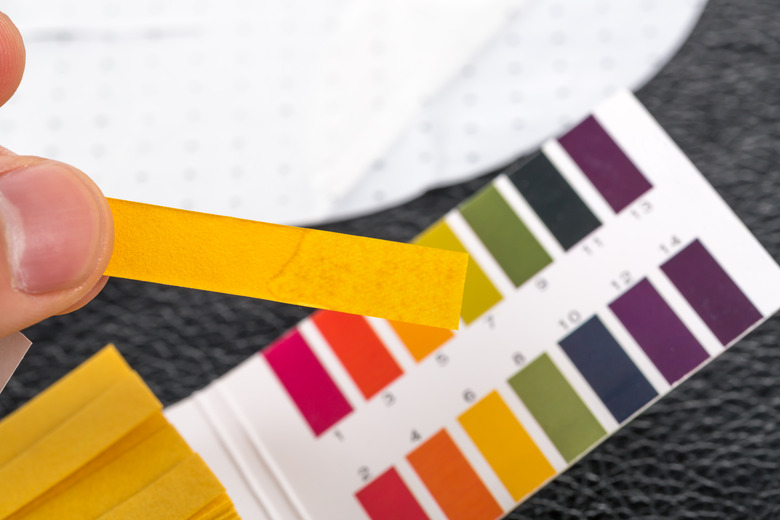How To Calculate Ph And pOH
The scales used to calculate pH and pOH are opposite sides of the same coin. While one tells you the concentration of hydrogen (hydronium) ions, the other tells you the concentration of hydroxide ions.
Usually, pH is reported on a 0-14 scale (though it is not an absolute scale). You may be familiar with the fact that at low pH value a substance is considered acidic, and at high pH value a substance is considered basic. This article shows you why that is and how to calculate both pH and pOH.
TL;DR (Too Long; Didn't Read)
In order to calculate the pH, take the negative log of the hydronium ion concentration. To find the pOH, simply subtract the pH from 14.
In order to calculate the pOH, take the negative log of the hydroxide ion concentration. To find the pH, simply subtract pOH from 14.
What Do pH and pOH Measure?
What Do pH and pOH Measure?
When a strong acid is added to water, there is an increase in the amount of hydronium ions (H3O+). This is because the hydrogen ion associated with the acid dissociates from the acid and associates with a water molecule. Take a look at the following example for HCl which is a very strong acid:
\(\mathrm{HCl(l)+H_2O(l) \rightarrow H_3O^+(aq)+Cl^-(aq)}\)
The pH gives you an indication of the concentration of H3O+ in the solution while the pOH gives you an indication of the concentration of OH-. But how do you actually get these numbers, and what do they mean?
How Do You Calculate pH and pOH?
How Do You Calculate pH and pOH?
The "p" in pH and pOH indicates "-log." The H or the OH in pH and pOH indicate the concentration of either hydronium ions (H3O+) or hydroxide ions (OH-). So, pH measures hydronium ion concentration, while pOH measures hydroxide ion concentration.
Only strong acids and bases completely dissociate in water. As a result, if you are given the concentration of the acid, you also know the concentration of the hydronium ions.
Say you have a 0.001 M solution of HCl. Since the acid dissociates completely, that means that your hydronium ion concentration is also 0.001 M. To find the pH, take the negative log:
\(\mathrm{pH = -log[0.001]}\)
So,
\(\mathrm{pH = 3}\)
The pOH is the negative log of the concentration of hydroxide ions. But based on the equation above, you don't know anything about the hydroxide ions, so what do you do?
In fact, for reasons having to do with the dissociation constant of water at 25 degrees C (which are outside the scope of this article):
\(\mathrm{14 = pH +pOH}\)
This means that if you know either pH or pOH, you know the other!
So, if the pH of your acidic solution is three, you can plug this in the equation above to find the pOH:
\(\mathrm{14 = 3 +pOH}\)
Thus,
\(\mathrm{pOH=11}\)
For a 0.001 M solution of HCl, the pH is three, and the pOH is 11.
You can also do the inverse calculation. Say you have a strong base which has a pH of 13. What is the pOH?
\(\mathrm{14 = 13 +pOH}\)
The pOH is thus:
\(\mathrm{pOH=1}\)
Identifying Acidic and Basic Solutions
Identifying Acidic and Basic Solutions
How can you tell at a glance whether or not a solution is acidic of basic based on these numbers?
Well, the pH scale is a convenient way to talk about acids and bases. A number on the pH scale tells you something about that solution.
1. At a pH < 7 the solution is considered acidic because of the high concentration of hydrogen ions.
2. At a pH > 7 the solution is considered basic because of the low concentration of hydrogen ions. 3. At pH = 7, the solution is considered neutral because hydrogen and hydroxide ion concentration are the same.
Cite This Article
MLA
Gupta, Riti. "How To Calculate Ph And pOH" sciencing.com, https://www.sciencing.com/how-to-calculate-ph-and-poh-13710435/. 8 March 2020.
APA
Gupta, Riti. (2020, March 8). How To Calculate Ph And pOH. sciencing.com. Retrieved from https://www.sciencing.com/how-to-calculate-ph-and-poh-13710435/
Chicago
Gupta, Riti. How To Calculate Ph And pOH last modified March 24, 2022. https://www.sciencing.com/how-to-calculate-ph-and-poh-13710435/
